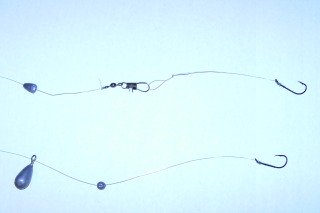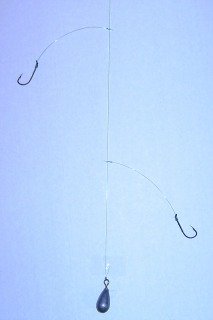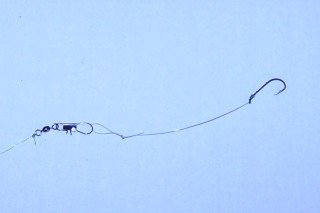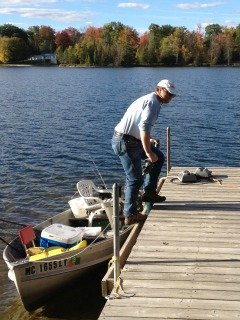Bullhead Catfish Fishing Tips: Part Two
Want to catch as many bullhead catfish as possible?
One key to a productive outing for bullheads is to use the best rig for where you're fishing. There are a variety of rather basic rigs that will do the job well for you. Here are the ones I use most often.
Three common bullhead rigs:
A simple bobber rig will work, and is especially helpful if you're fishing over a snaggy bottom. The rig consists of a bobber fastened up the line from the hook, with a split shot added to the line if desired. The float should be set far enough from the hook to keep the bait near bottom without getting stuck on it.
Since so much bullhead fishing is done at night, it’s a good idea to use lighted bobbers.
Another standard rig is the sliding slip-sinker rig. Ordinarily, bullhead catfish can sense any sinker weight when they pick up a bait off the bottom. Some of them will drop the bait because the extra weight is unusual and doesn‘t feel right.
However, with the sliding slip-sinker rig the fish won’t sense as much weight, if any. The bullhead can swim away, simply pulling line though the sinker. This rig keeps the bait in place on the bottom, but tricks the fish into thinking it’s picked up an ordinary meal. You can use any style of sinker that makes sense for the bottom type where you’re fishing.
Another common rigging consists of a sinker at the end of the line and a hook up the line a foot or more off the bottom. You can also tie a couple of dropper lines on and fish with two baited hooks. Sometimes you’ll catch two fish at once when you’re using this style of rig in a good spot.
You'll have to be careful with double-hook rigs when baiting and when unhooking fish. Using two hooks adds a little danger, especially when a bullhead starts thrashing around in the bottom of your boat on a dark night.
This rig is not a hot idea when you're fishing with kids; it's something to try once you've got some experience handling bullheads and unhooking them safely.
You can use setlines and trotlines where these are legal, but they won’t be as much fun as catching fish on a rod and reel or cane pole.
Selecting hooks:
You’ll need to use long-shank hooks. The long shank can give you something sizable to grab onto with pliers when you’re trying to remove hooks from deep within a bullhead’s mouth.
The best hook sizes are size 2 and 4. Strong, large diameter hooks are good. This is not the time to use thin, Aberdeen style hooks. Bullheads are strong for their size and they can break or bend these as they thrash around.
Bullhead catfish will very often swallow your hooks. You can try to set the hook earlier, but this will result in not hooking a fish on a great number of your bites.
My solution is to use only pre-snelled hooks. I attach a snap swivel to the end of my line, then put the loop of the snell inside the snap.
When I catch a bullhead that has swallowed the hook, I simply undo the snap, take the snelled hook and bullhead attached to it, and toss both in the live well.
Then I grab another snelled hook, attach it, and re-bait. I get the hook out of the bullhead later when I’m cleaning it.
If the bullhead is too small to keep, I cut the line and leave the hook inside the fish. It’s better to release a few small hornpout with hooks in their bellies than to rip the fish apart trying to get a six-cent hook out. Besides, many of these released fish will survive despite the hook inside them.
You can also try using circle hooks, but I’ve found that with both bullheads and bass, if the fish have the bait too long before you reel up, they still swallow the hook. Circle hooks may work better if you start reeling soon after getting a bite.
Whatever style you use, you’ll want to use very sharp hooks. You want to hook every bullhead that bites.
Bullheads usually hit a bait hard; they are not sissies about it, although some nights they are less aggressive than others. When you get a bite, it’s best to give the bullhead about five seconds to swim away with the bait. You’ll then set the hook with a sharp upward motion of the rod.
This type of hook-set is similar to what you’d do when fishing for walleyes with live bait. You don’t need to use an extra hard hook-set like you’d do for bass.
Gear choices:
You’ll want to use rods and line that are strong enough to catch other species that may bite while you‘re targeting bullheads. You're liable to hook up with good-sized catfish while using bullhead bait. Northern pike do some scavenging too, and have eaten my bullhead baits on a couple occasions.
It’s smart to use fairly strong monofilament line (10-20 lb. test), unless you know there are no catfish in the body of water.
Of course, if you want more sport, you can scale down to 4 or 6 lb line and panfish gear. Walleye gear is about the right size if you're fishing a spot with large bullheads or decent-sized catfish prowling.
Super-Charging Your Bullhead Fishing
After you’ve found the best locations for the season, fine-tuned your bait selection, and got the right rigs ready to go, what can you expect to catch under perfect conditions and with lots of preparation?
100 bullheads in a day (or night), if you’ve prepared properly.
You’ll start by doing some research to find lakes that have big populations of decent-sized fish. This is done by checking out studies performed by your state’s wildlife and/or conservation agencies. They will often post the results of their population surveys online. These show how many fish of each species were netted during various studies, and their sizes.
Many lakes have no information posted about them online, so you’ll also need to ask around at tackle shops, ask fishing buddies for advice, and pester old-timers for their secrets.
Some lakes have enormous populations of hornpout, but the fish are very small because there is too little food to go around. Other lakes have plenty of food but a small population of bullheads; the bullhead catfish in these lakes will be large but not plentiful. You can save these lakes for later, as great places to try for a trophy bullhead someday.
Your goal will be to find several lakes that are loaded with keeper-sized bullheads. You’ll then pick your favorite, get a map, and start learning the lake.
Super-charging your bullhead fishing may require up to a week‘s preparation on unfamiliar water. The plan is to start spending several hours each day and a couple hours each night finding great spots that are loaded with bullheads, then pound them all on the final night.
Your preparation time should be spent trying to catch fish in areas you’ve identified as likely bullhead spots, based on the seasonal location patterns above. Also, you’ll be testing different baits to see what is getting the best results.
If you succeed in finding a spot where bullheads bite during the daytime, the chances are you’ve found a great location with lots of fish present. They should really turn on at night!
Of course it is possible that they will head for shallower nearby areas at night. This means you’ll need to spend some of your night hours determining whether a good daytime spot continues to pay off at night, or if the fish move up shallower and must be caught there instead.
Your goal during this searching phase is to find four or five great spots that are relatively close to each other. Once you have done this, you will be ready to do the big trip.
You will set off fully prepared on the night of your grand bullhead quest. After comparing different baits all week, you’ll know what baits are working best, and be loaded up with the top choices. If you've developed your own Super-Bait, bring it along. It's time for it to shine.
When going all-out for bullhead, I take five rods with double-hook rigs. The more hooks and bait in the water, the better. I keep a bait bucket close at hand in the boat so I can quickly re-bait my hooks. This is especially important when I’m getting tons of bites fast.
You’ll arrive at the first spot an hour before dusk, and begin by chumming the area to attract bullheads and stir them up into a feeding frenzy. You’ll keep fishing here until the action dies down, hopefully catching at least 25 bullheads to start the night.
Then you’ll move to the other nearby spots you’ve found and do the same thing. Chum and fish. Catch a bunch. Move to the next spot and do it again.
With four or five top-quality spots, plenty of the most potent bait, and lots of rods to get it all out there, you should be getting bites like crazy. This will give you a good shot at a 100-fish night.
An exceptionally good night may produce 200 if you’re lucky! You may need to go with a friend just to be able to handle all the rods, fish, and constant action.
Lastly, you should not tell other anglers about your spots. You spent considerable time and effort to find the best areas; nobody else did anything. By keeping what you know to yourself, you can ensure great catches down the road with regularity.
Sure, you might tell a few close friends, or trade information with someone who knows great spots for bass or whatever. But on the whole, it pays to keep secrets, especially on a small lake with just a few key spots.
You may also come up with some unusual ways of fishing that most people would never consider.
For instance, the two guys in this video don't even use hooks. They search the shallows with a light to find bullheads and lower a gob of worms into the water.
When a bullhead bites, the angler lifts it out of the water while it's still biting down on the worms. The fish lets go and falls into a plastic bin in their boat. It looks like it works pretty well; they seem to be catching fish very fast!
Handling Bullhead Catfish
Getting bullheads out of the water and into the frying pan can be a cumbersome chore. But it’s easy when you know what you're doing.
I minimize the risk of stings by refusing to hold live bullheads with my hands. Instead, I stick a small pair of jaw spreaders inside their mouth to hold it open. Then I remove the hook with pliers unless it has been swallowed.
At this point, the bullhead’s mouth is pinned open by the tension of the jaw spreaders. Holding the bullhead over my live well or bucket, I press the spreader arms together to release the tension and the bullhead falls into the bucket. In this fashion I never even touch the fish. So far I’ve never been stung by a bullhead.
(Note: Jaw spreaders are commonly used to deal with northern pike and other toothy fish. A very small pair is the only appropriate size for dealing with bullheads.)
A bullhead will often make a grunting sound when it is out of the water. This is no big deal, though it may surprise you the first time you hear it. The fish is simply releasing air from its swim bladder (an internal organ). If you’re holding the fish, you’ll feel its body vibrate as it makes the noise. You’ll get used to the croaking sound and vibrations after a while.
Cleaning Bullheads
Most of the year, bullheads taste great. However, there is one period of the year when you may not want to keep them. When water temperatures get high in the middle of summer, bullhead meat loses its firmness and it can actually taste a bit muddy. You’ll have to eat a couple bullheads in late summer to know if this happens in the waters you fish.
At some point when the water cools down and fall is approaching, the fish will begin to taste great again.
To prepare bullheads to be cleaned, they need to be killed in a quick, painless manner. Dispatching bullheads is not easy. Bashing their heads with a hammer works, but it can be nasty and often takes multiple blows.
Fortunately, there’s an easier method that produces even nicer looking fillets. You start by getting a bucket full of cold water. Holding the live bullhead by the mouth with pliers, you take a sharp knife, slide it in behind the head by the gills on one side, and make a cut to the gills.
Then you’ll put the fish in the bucket and it will bleed out. Even a bullhead can’t live without oxygen forever, and it will die quietly. Do the same with your entire batch of fish, then start pulling out dead ones to clean.
The first step is to cut off the tips of the dorsal fin and two pectoral fins so that you can’t get stung. Even though the bullhead is dead, you could still get poked and hurt by those painful fins.
You can cut these fin tips off with a pair of kitchen shears. (Once you gain experience, you can skip this step.)
You might have heard or tried the “nail the bullhead to a board and skin it” routine. My advice is to forget that idea. It’s too hard and too slow.
There are two good ways to clean bullheads. The first is to pop the backbone and pull the fish apart. This video gives a good example.
The method also works on small catfish. It's fast, but it does leave the bones in.
Filleting is my favorite way of cleaning them. If you angle the knife so that the cut on each side is made in a line between the dorsal spine and the anal pore, you can avoid cutting into the rib cage and getting into all the guts.
Horned pout have lots of nasty guts, and your fillet board will be cleanest if they are not spilled.
If you do penetrate the guts, you may find thousands of yellow eggs inside the fish; this is an obvious indication that the fish is a female that was about to spawn. You may want to keep the eggs, stick them in a blender with something else, and then try them out as bait.
While
cleaning the fish, you can also recover any hooks that were swallowed.
Obviously you don’t want a hook turning up on your plate in a fillet!
Learning
to clean hornpout can be very hard and seem impossible at first. The
good thing about cleaning any species of fish is that
once you become familiar with their anatomy and gain some experience, you get much faster and more confident about it.
Coating the fillets with a tasty fish batter and frying them is my favorite way to cook bullheads. The restaurant in this video uses deep frying.
Since the fillets are generally small, three or four 12-inch bullheads are enough for one hungry adult. A good meal puts the finishing touch on each trip.
By the way, keeping quite a few bullheads is often good for a lake's population.
It prevents overcrowding and keeps the average fish size higher. Since many people don't fish for bullheads at all, it's okay for you to keep more than your fair share in many waters.
A Few Final Thoughts
Bullhead fishing should be enjoyed by more people, but bullheads are often overlooked and misunderstood. On my home lake up north, many people don’t even realize they are in the lake. As they go to bed after a long summer’s day of boating and swimming, I set up for a night of black bullhead fishing.
I usually start by placing several poles along our dock. Bells are clipped to the rod tips and I sit down and build a fire. After twenty minutes to an hour, I get the first few bites. Then the action heats up for an hour and it's easy to catch fish.
Eventually the action slows, and only an occasional fish bites. Then there will be a dead spell where nothing happens. The bite is over and the fire burns down. This is the signal that it’s time to go to bed.
There are some fish that bite very late at night. I remember getting woke up by a ringing bell at 3 AM one night. I was down by the dock sleeping in a tent. I had to get up and take the bullhead off the line.
If I wanted to stay up all night, I could catch a few more. But, since I have found the best action on my lake happens within the first few hours of darkness, that’s when I usually fish for bullheads. This way I can go to bed at a decent time.
Premier Bullhead Fishing Tips:
- I recommend that you start writing down
notes about your bullhead fishing trips or using software to record your
results. This is especially useful if you’re fishing the same lake or
river repeatedly over the years. You'll begin to get a feel for the best
locations and any unique ways the bullheads behave in that body of
water.
- After you have notes for a year or two, they become a real
asset to you, almost like a great fishing book that is customized to
your own lake. I find that reading my notes from prior years always
gives me fresh ideas, plus it’s kind of fun to read about my past trips.
- Bullheads are fantastic fish to pursue because of their abundance, willingness to bite, and great taste. By using these tips, you will be sure to catch more bullheads than ever before.



